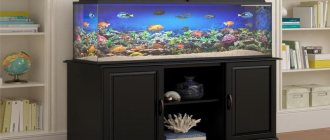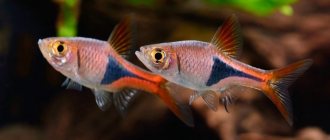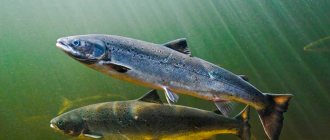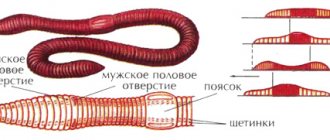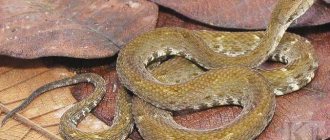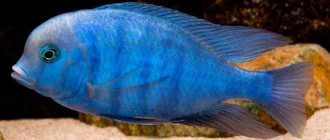Elegant South American cichlids are rightfully considered one of the most beautiful aquarium fish. The peaceful Pterophyllum Scalare looks like an angel due to the peculiar shape of its fins. This predator, originally from the Amazon and Rio Negro rivers, has been successfully bred at home for a very long time - more than a hundred years. All types of angelfish, as well as existing selective subspecies, are not inferior to each other in aristocratic gloss.
Angelfish in their natural habitat
The first description of angelfish was made by researcher Schulze back in 1823. The fish came to Europe in 1920, and already in 1930 it was successfully bred in the USA. Although modern fish of this family are called common, and they are not difficult to find on sale, they differ significantly from their natural relatives.
In nature, angelfish live in South American reservoirs with slow currents. Their homeland is considered to be the central Amazon and its tributaries in Peru, Brazil, and eastern Ecuador. Under natural conditions, angelfish need a pond with a small amount of plants; their food is fry, insects, invertebrates, and vegetation.
Ideal conditions
These tropical fish, no more than 15 cm long, require a water temperature of 24 to 28 degrees. PH value from 6 to 7.5. A tall aquarium with a volume of at least 100 liters will ensure good health for angelfish.
Due to the fact that all “freshwater angels” are quite peaceful, they can easily get along with catfish. Also good companions will be Lyalius, Blue Gourami, Shark Baloo and Zebra Pleco. When choosing companions for angelfish, you should pay attention to fish with the same low level of aggressiveness . Since cichlids are schooling fish, it is highly not recommended to keep them alone. It is better to buy individuals in pairs - 2, 4, 6, etc. In nature, angelfish live in schools of two dozen fish.
Species diversity
Subspecies of South American cichlids have many popular names. Below is a description of some of them.
Common angelfish
The average size of one of the most common fish in pet stores is 22 cm. Due to the shape of its fins and silvery color, it is often called the “moon fish.”
Adults are distinguished by a dark accent on the forehead and back. Despite its wide distribution in specialized stores, breeding forms of angelfish have pushed this species into the background.
Leopold's angelfish
It is distinguished by its relatively short body length - no more than 15 cm. Due to the length of the front part of the body, it is called “long-nosed”. Pterophyllum leopoldi does not have a bright color; even dark stripes are difficult to see on the dull brown fabric. This species has more proportional fins than those of the common angelfish, so it looks more harmonious. During breeding, a school of 6-7 fish divides in pairs, and after the fry hatch, they are reunited again.
Diamond
This species is related to the golden angelfish. It has a fascinating bright silver color. Some individuals have dark stripes. Pterophyllum scalare diamond deserves its name precisely because of the color of its scales, which play beautifully in the light, as well as its almost transparent fins. It is very popular among breeders who are actively trying to develop new breeds using it.
Angelfish bicolor
A distinctive feature is body color. It is dominated by two colors - silver and black. There are no stripes, instead there is a clear boundary between light and dark tones. If it happens that Scalare bicolor suddenly shows stripes, it immediately noticeably loses in price compared to its traditional counterparts.
Angelfish altum (or high-melting)
In the wild, some individuals had a profile reaching 45 cm in height. The appearance of Pterophyllum altum is very similar to the common angelfish, except for a more distinct pattern. This gracefully finned breed loves space and can be irritated by small, crowded aquariums.
Platinum angelfish
It owes its nickname to its light silver shining color.
Blue Angel
The blue angelfish, beloved by many, is more valuable if it has a more saturated hue. Scalare blue admirers prefer individuals without dark stripes. The cost of one fish with translucent blue fins reaches almost one and a half thousand rubles.
Golden angelfish
Despite the precious name, the ancestors of this species are the most common angelfish. The golden rock is unpretentious and is painted a pale silver color with golden areas. There may be very little yellow tint, or, on the contrary, it may occupy a significant part of the body, which is framed by large fins.
Leopard angelfish
This type of angelfish is painted in black and silver shades in a ratio of 50 to 50. It is thanks to the bizarre shape of the black spots that the fish received such an elaborate name. The breed is not at all suitable for living in dense places; for a comfortable life it needs free space.
Koi angelfish
The white canvas of their body is decorated with black strokes, and the head (sometimes other parts of the body) has a shade from orange to bright red. The smaller the bright spot, the more expensive the angelfish. Due to the coloring, similar to koi carp, this breed acquired the name Koi angelfish. Interestingly, it is difficult to find two individuals with the same coloring.
Red Devil
The red spots present in the Koi angelfish gave rise to a new breed. The fish has an ominous name, but it is very peaceful and not at all dangerous. There are practically no spots of a different color on the body of individuals, and the most expensive specimens are those with a complete absence of all colors except red.
Marble angelfish
They appeared from the species of common angelfish. Unlike its parent, the marbled species is smaller in size. In addition, these unpretentious angels are easier to keep than other breeds. The color contains silver and black colors, stripes, spots of different shapes. The fish received its nickname precisely for the combination of spots reminiscent of the rock of the same name. An aquarium with a capacity of more than 60 liters will be a suitable home environment for her.
Zebra (striped angelfish)
Like the wild horse breed, its color is replete with black stripes. It may seem that it is very similar to the most common type. This is true, the difference is that the stripes on the zebra’s body are more clearly defined. There are more than four of them on the body of these individuals.
Black angelfish
A widespread species, since it was bred by breeders many years ago. To breed pure black fish, individuals with extensive black spots were selected. It took a lot of work to get a perfectly black cichlid. Sometimes you can still find “black velvet” with areas of silver and gray shades. Typically these spots are located on the abdomen and fins.
Angelfish pink glowing
Breeders have nothing to do with it; the species appeared thanks to genetic engineering. was able to create a stunning pink glow-in-the-dark fish. Due to the high cost, few people purchase the radiant beauty, so it is not particularly widespread in Russia. There are unverified rumors that the pink angelfish lives very little and cannot have offspring.
Angelfish dantum albino
Graceful and smoothly moving descendants of Rio Nanay. It has long sailing fins, thanks to which the height of the fish can reach 27 cm. This white angelfish is photophobic and does not see very well. She will like aquariums with many grottoes, stones and areas shaded by plants. Albins are not known for their sociability; the best neighbors will be a few individuals of the same species.
Veiled angelfish
This breed is famous for its curved translucent fins. They have an elongated shape and can be painted in different colors and have different patterns. Since fins attract the attention of aggressive fish, angelfish should be isolated from Sumatran barbs, macropods and large cichlids. However, inhibited veil individuals irritate even neon and minor colors. Ideal companions would be bottom species (since angelfish love to be on the surface of the water and almost never sink to the bottom), as well as goldfish.
Pearl
Freshwater angels owe their iridescent color to genetics. The fact is that pearliness is not a distinctive feature of a selective species, but a manifested recessive gene. Dark-colored angelfish, unlike light-colored ones, rarely boast of this quality, since the iridescent highlights are invisible on their scales.
Paraiba angelfish (phantom)
This is the name given to fish that have a double gene for asexuality. Sometimes blue pearl angelfish are called by this unusual nickname.
Jacobin
Their feature is a more elongated body shape coupled with wide fins.
Birch
It is distinguished by clearly visible vertical stripes and is painted silver.
Dwarf
This is, rather, not a form, but sometimes mini-fish. Perhaps their growth is affected by improper feeding or insufficiently thought-out living conditions.
Angelfish - who are they?
Angelfish belong to the Cichlid family. In Latin interpretation, the name of the breed sounds like Pterophyllum scalare, which means winged leaf. Aquarium species of angelfish are distinguished by a variety of colors, but in nature there is only one color of these fish.
Representatives of this species originate from South America and prefer the waters of rivers such as the Amazon, Orinoco, and Essequibo. The fish can be found in Brazil and Peru. Angelfish feel comfortable in slow-moving bodies of water with dense vegetation.
The body structure of the angelfish is designed specifically for turbid waters
The body of the fish has the shape of a disk, compressed from the sides. The ventral and dorsal fins are highly elongated and resemble a sail. The flattened, flat body and high fins give angelfish a crescent shape.
The main color of most individuals can be either grayish-green or silver-olive. The back is usually darker in color than the belly. Four dark stripes run vertically across the body. Males are distinguished from females by a more convex forehead.
Thanks to their beautiful color, elongated fins and calm disposition, angelfish received a second name - “angel fish”.
The flattened body helps the fish easily maneuver between underwater plants, and thanks to the dark stripes they are not so visible to predators.
Angelfish are much larger in height than in length. The maximum length of the fish can reach 15 cm, and the height – 25-30 cm.
Maintenance and care of angelfish
Angelfish are quite large fish, so to keep them you should choose containers of at least 60 liters, the height of the aquarium should exceed 45 centimeters, the width does not play a big role, since angelfish are adapted to live in narrow channels. The water should be clean and slightly soft, the acidity level should be kept between 6.5-7.4 pH, and the constant hardness should not exceed 18. Angelfish are quite sensitive to the environment, so it is advisable to maintain water parameters at the same level.
It is better to keep cichlids in small groups; it is advisable to choose a large aquarium for them, densely planted with plants. It is worth remembering that these fish are shy; a sudden light or knock can frighten them. Angelfish are peaceful, but during spawning they jealously protect their territory from their relatives.
Feeding is not particularly difficult. Cichlids mainly feed on live food. Young angelfish eat live daphnia, tadpoles, and various insects. They happily consume granular and flake food, and gnaw algae or leaves of delicate aquatic plants. It is worth considering that due to the specific shape of the body, it is difficult for angelfish to pick up food from the bottom, so you will have to come up with special feeders. It happens that fish, for no apparent reason, refuse food for a week, but then begin to eat again as if nothing had happened. You can give the fish chopped seafood - mussel, octopus or shrimp meat.
When keeping representatives of the cichlid family, you should follow simple rules. If several pairs live in your aquarium, plant a large bush with wide leaves in different corners. This technique will reduce the level of conflict. Never give fish low-quality food; angelfish are very sensitive to its quality. Be sure to create shelters - caves, darkened areas, snags, stones. Also welcome are plants floating on the surface, which will dim the bright light. There should be a minimum of decorations in the center and near the surface so that the cichlids can swim freely.
Compatibility of angelfish of different subspecies
Angelfish is a non-conflict, peace-loving fish. An aggressive state is characteristic of it only during reproduction.
The compatibility of fish is affected by the volume of the aquarium. The larger the container, the more neighbors you can add to the “angels”. But it is not advisable to keep small fish together with angelfish, as they can become food for representatives of the cichlid family.
Angelfish look great both in a species and in a general aquarium.
At the same time, “angels” can be attacked by other inhabitants because of their long fins. Angelfish get along well with platies, tetras, catfish, ancistrus, corydoras, and mesonauts.
Same-species relatives that have the same color and approximately the same age coexist well in the same aquarium, excluding individuals outside the pair. If there are more males in the flock than females, then manifestations of aggression on the part of the “boys” are possible.
You cannot add young specimens to the “angels”, as they may die due to lack of food. Adult brothers are more agile and young individuals will not get food.
The unusual appearance and interesting behavior of the angelfish will decorate any aquarium. You just need to follow all the rules for keeping “angels”, excluding stressful situations. With proper care, fish can live up to 10 years or more.
Sex determination in angelfish and pair formation
Sexual dimorphism in angelfish is not pronounced, i.e. males and females are almost the same in appearance. It is impossible to determine gender before the onset of puberty, and even then it is quite difficult. Aquarists joke about this: “If it swam, it means a male, if it swam, it means a female.” However, in adult angelfish it is possible to determine the sex in most cases, although this can usually only be done by those who know the anatomy of fish well. Let's try to figure out what characteristics determine the gender of fish of this genus:
- In mature males, there is a fatty hump on the forehead;
- Males have a more convex pectoral carina;
- If you look at the fish from the front, then the lower part of its body resembles a wedge, and in the male this wedge is sharp, and in the female it is blunt;
- The diagnostic sign is the genital papilla (in females it is called the ovipositor) - a growth with an opening located between the anus and the anal fin, through which reproductive products come out. In females it is larger and thicker, while in males it is correspondingly thinner, sharper and directed backwards. These differences are especially clearly visible during spawning, as well as before and immediately after it;
- The distance from the genital papilla to the anal fin is much shorter in males than in females. In fact, in males the fin keel grows directly from the genital papilla, and since in striped angelfish the papilla is usually located at the base of the central stripe, we can say that in males the anal fin starts from the base of the central stripe, and in females - behind it;
Male angelfish differ from females in having a more elongated, long dorsal fin. In its rear part there are dark transverse stripes interspersed with gaps. The number of these stripes in females is no more than 6, and in males there are no less than 7.
However, sometimes it is impossible to reliably determine the gender of fish based on these characteristics, especially in artificially bred forms with marbled, golden, albino coloring. In such cases, they try to determine the sex of the fish by their behavior when they form pairs and begin spawning in a common aquarium. But this does not always work: in some cases, in the absence of males, females play their role in mating games and spawning, and same-sex couples even lay eggs (which, naturally, remain unfertilized).
Here we can advise the following: if you want to purchase an adult breeder fish, choose an individual with characteristic features and behavior, or a fish that has already given birth to offspring. It’s even better if it’s an established couple right away. If you are going to raise breeders yourself, purchase 8-10 fry with wide and long fins, among them there will definitely be individuals of both sexes, and in the future they will split into pairs themselves, and you can decide which of them to use for further breeding.
Angelfish prefer to form pairs on their own, choosing a partner from several individuals of the opposite sex. But the aquarist may well choose a pair of an existing young specimen. When a male and female angelfish of similar age and size find themselves alone in an aquarium, as a rule, they begin to “build love.” It is not recommended to separate ready-made couples and select other partners - this is extremely stressful for fish, and they do not always form new unions. It is easy to identify a formed pair: the fish stay together, swim in single file, and the male begins to drive the female into the corners of the aquarium.
Common angelfish
The most famous species of Pterophyllum is the common angelfish. It has a characteristic appearance for this genus: a tall, laterally compressed body, elongated fins, pointed at the ends.
The scales are painted silver-gray with a blue tint, and the eyes are red. The entire body is crossed transversely by four stripes, the first of which passes through the eyes, and the last along the surface of the caudal fin.
The intensity of the color of the stripes is influenced by the emotional and physical state of the fish.
The pelvic fin resembles a mustache, and the dorsal and anal fins are stepped.
It is difficult to distinguish females from males. The difference can only be noticed during reproduction through the pointed and narrow vas deferens that appears in males.
Reproduction in an aquarium
Angelfish form a stable, monogamous pair, and they actively spawn in a common aquarium, but it is quite difficult to preserve eggs. As a rule, eggs are deposited on vertical surfaces: a piece of driftwood, a flat sheet, even on glass in an aquarium. For propagation, special devices are often installed, either cones, or a piece of plastic pipe, or a ceramic pipe. Like all cichlids, angelfish have developed care for their offspring. Reproduction is not easy spawning, the parents take care of the eggs, and when the fry hatch, they continue to care for them until they swim.
Since angelfish choose their own mates, the best way to get such a mate is to buy six or more fish and raise them until they decide. Very often, the aquarist only learns about the beginning of spawning when he sees eggs in one corner and all the inhabitants of the aquarium in another. But, if you are careful, you can see a couple that is preparing to breed. They stick together, drive away other fish, and guard a secluded corner in the aquarium.
Angelfish usually reach sexual maturity at 8-12 months, and can spawn every 7-10 days if taken from them. Spawning begins with the pair choosing a place and beginning to methodically clean it. The female then lays a chain of eggs, and the male immediately fertilizes them. This continues until all the eggs (sometimes several hundred) have been laid; the angelfish eggs are quite large and light in color.
The parents take care of the eggs, fan them with their fins, and eat dead or unfertilized eggs (they turn white). After a few days, the eggs hatch, but the larvae remain attached to the surface. At this time, the larva does not eat yet; it consumes the contents of the yolk sac. After about another week, she becomes a fry and begins to swim freely. You can feed angelfish fry with Artemia naupilium or other fry food. Millions of angelfish fry have been raised on Artemia naupilii, so this is the optimal choice. They need to be fed three to four times a day, portions of which they can eat in two to three minutes.
In an aquarium with fry, it is better to use an internal filter with a sponge and without a lid, as it provides sufficient filtration, but does not suck the fry inside. The purity of the water is as important as regular feeding; it is because of the accumulated harmful substances that the fry most often die.
Aquarists often ask why angelfish eat their eggs? This can be due to stress when they spawn in a common aquarium and are distracted by other fish, or in young couples who are still inexperienced.
Aquarium mates
Aquarium fish, angelfish, are considered sociable fish, but can be aggressive towards fish.
Christmas tree neighbors. While angelfish are young, they are quite peaceful, but as they age, they become a territorial fish. When they pair up, they become aggressive and fiercely defend their breeding territory.
Avoid proximity to aggressive biting fish - they can encroach on the “wings” (fins) of the angels.
Feeding
What to feed? Angelfish are omnivores; they eat any type of food in an aquarium: live, frozen and artificial. The basis of feeding can be high-quality flakes, and additionally give live and frozen food: tubifex, bloodworms, brine shrimp, and coretra. It is important to know two things, they are gluttons and cannot be overfed, no matter how much they ask. And give bloodworms very carefully, and it is better to refuse it altogether. A slight overfeeding of bloodworms, and the angelfish begins to bloat, so much so that pink bubbles stick out from the anal bladder. It is much safer to feed with branded food, since it is now of high quality.
Angelfish can pick off tender plants, although not often. They regularly tear off the tops of my eleocharis and tear off the moss from the snags. In this case, you can add food with spriulina to the diet.
What to feed your koi angelfish?
The fish are omnivorous and absolutely unpretentious when it comes to food. Hamsters, both live and specialized food. As for branded foods, we recommend using time-tested Tetra foods. You can find out detailed information about them on the company’s official website - here .
Whatever your choice of food for aquarium fish, when purchasing, be sure to look at the expiration dates of the product, and do not buy food in bulk or in damaged packaging. Like any product, fish food deteriorates and if storage conditions are violated, pathogenic flora develops in it.
Natural conditions of existence
- The wild species was brought from South America, the northern part of the continent, from tributaries of the Amazon River flowing in Brazil, Peru, and the eastern part of Ecuador.
- The flat, disc-like body shape serves for improved maneuverability between underwater reed beds.
- It lives in groups of ten animals or more in river lagoons; they live in water filled with stagnant water or with a barely noticeable current among dense vegetation.
- Food includes various representatives of the insect community, invertebrates, and plants for angelfish. Does not swim past the fry.
Species and breeds
The following species of pterophyllum angelfish are distinguished: the common angelfish, the altum angelfish (high-bodied) and the leopold angelfish (the previous name was Pterophyllum Dumeril).
SCALARIA COMMON
This type of angelfish is more common and adapted to living conditions in an artificially created habitat. The angelfish is considered the most unpretentious to keep in an aquarium, amenable to selection and reproduction. A variety of colors and fin shapes is provided by numerous breeds of this species:
- phantom,
- two-spotted phantom,
- zebra angelfish,
- zebra lace,
- smoky,
- smoky red,
- pink angelfish,
- red,
- angelfish birch,
- half black,
- half black red,
- pearl angelfish,
- platinum angelfish,
- pearl red,
- pearl gold,
- marble red-gold,
- leopard angelfish,
- cobra,
- chocolate,
- blue,
- white angelfish,
- albino and many others.
Some breeds have been known for decades; there are also those developed recently.
LEOPOLD'S SCALARIA
This variety is renamed in honor of the Belgian king, a lover of zoology, Leopold III. Distinctive features from the other two varieties are the wide occipital part, the straight contour of the back, and a large dark spot at the base of the dorsal fin. It is extremely rare. It is difficult to obtain offspring in aquarium conditions.
SCALARIA ALTUM
In another way, Orinoco (by the name of the only natural habitat of existence). Large sizes stand out against the background of their species counterparts. Capable of reaching almost half a meter in height (including fins). The owner of a sharp transition from the mouth to the forehead with the formation of a depression. Characteristic are the red tints of the transverse black stripes. The scales are smaller in size, unlike other angelfish. Cases of breeding in captivity are very rare. The bulk of sales are made up of imported individuals from their native habitat.
Appearance. Description
The standard is the specific appearance of the common angelfish in the aquarium. The body is elongated in height due to narrow and elongated upward sails of the dorsal fin and downward anal fin. The disc shape is achieved by flattening the sides. The basic color is a silver background with vertical black stripes placed along it (the brightness depends directly on the condition of the fish). The color is intended to camouflage in wild habitats between plant natural decorations and roots. Other colors were developed through selective breeding. Veiled angelfish have also been selected. When reaching sexual maturity, thin and long rays develop on the tail of some individuals. The dimensions depend on how many liters of water are per specimen. These aquarium fish reach 15-20 centimeters and can live up to fifteen years.
Aquarium conditions
Aquarium for angelfish. For one pair, you should select a volume of at least one hundred liters. For a larger number of individuals, a displacement of two hundred will be required. An important detail is the height of the vessel, equal to half a meter. Under such conditions, they can possibly grow 26 centimeters in fish height, and increase the safety of eggs from being eaten by parents. The use of the top cover is impractical due to the inactivity of the inhabitants and the absence of rapid jumps above the surface of the water surface.
- The soil is used in the form of coarse sand or fine gravel.
- The interior is selected at the discretion of the owner with the main condition: the absence of sharp edges to avoid injury to the fish. They do not need shelters, but they do need free space for free swimming.
- Plants must be selected broad-leaved (amazons, nymphs) and with long stems (Vallisneria, Cryptocoryne, Echinodorus) to imitate natural conditions. They can eat eleocharis and Java moss. Movement among dense thickets is a common activity for the adapted bodily forms of these amazing creatures.
- Filtration should be organized without the presence of a strong current, which causes stress conditions and slowdowns in growth, due to increased energy costs in the fight against the flow. The use of an external filter is recommended.
- Good aeration ensures the saturation of water layers with sufficient care for angelfish and oxygen content.
- It is advisable to provide moderate lighting. Local shading is achieved using vegetation. Install the water tank in a place deprived of bright rays of the sun.
- For a comfortable existence, the water is kept at a fairly soft and weak acidity.
The water temperature in the aquarium is maintained within twenty-two degrees above zero at the lower limit. It is not recommended to raise the upper value above 27C (with the exception of the spawning period). Sudden temperature changes are dangerous. A partial water change of up to one quarter of the total volume of the aquarium is required weekly.
Nutritional moment
The question of what to feed the angelfish does not cause much trouble due to its omnivorous nature. Willingly feeds on both live and dry food. With a specific body structure, it is worth considering the difficulties of picking up settled food debris from the bottom covering. More acceptable is the one that is able to linger for a long time in the upper layers of water and on its surface.
- Live food can be represented by tubifex, bloodworms (should be given with caution; overfeeding may cause bloating), small crustaceans, earthworms and snails. You should not offer your wards meat components made from chicken, pork or beef. Aquarium angelfish are not able to digest the animal fats contained in these products. Can be replaced with chopped seafood (mussels and shrimp).
- Plant food consists of scalded lettuce leaves and spinach.
- Dry food for some breeds is selected with microelements added to the composition, which contribute to the richness of the scaly colors. Granular ones containing spirulina are also used.
Feeding is maintained three times a day, strictly dosed distribution of food supply. This will serve as a preventive measure to prevent obesity. One day a week should be free from feeding. The given single portion is meant to be eaten within five minutes. Excess will settle to the bottom, polluting the aquatic environment, which can lead to diseases. The basic rule is based on the balance and variety of feeding of aquarium inhabitants. Do not be alarmed if individuals ignore feeding for a long period of time (up to a couple of weeks). Most often, this indicates oversaturation and is not dangerous.
Neighborhood criteria
Keeping these angelfish in a community aquarium is possible provided that certain recommendations are followed. Small fish, shrimp, and fry are in danger of being eaten in such proximity. Possible combination:
- swordtails,
- thornetium (can gnaw the fins of angelfish)
- zebrafish,
- various types of catfish,
- parrots,
- gourami
- platies
- mollies. You should not experiment with predators:
- goldfish,
- discus,
- guppies (all varieties),
- neon,
- cardinals,
- barbs (without exception).
Waiting for replenishment
Breeding angelfish is possible both in a common habitat and in a separate tank. Procreation is stimulated by adding a fresh water component and increasing the temperature to 30-32 degrees gradually, over several weeks. Aquarium angelfish create pairs once for the entire period of their existence. Formed during the process of growth from a group into several individuals.
Sex differences
Once puberty is reached closer to the first year of life, signs of separation of the sexes become more noticeable to experienced aquarists. The difficulty is the ability of two females to pair up and alternately imitate the behavior of the male. It is possible to more accurately determine the age of sex during the spawning period. The female exhibits a short, thick ovipositor, while the male develops a gonopodium.
Features of spawning
To lay eggs at home, a couple selects a plant with a wide leaf, a flat stone, a glass surface, or a flat wall for decoration. The treasured place is protected from those who want to encroach on its integrity; anyone who approaches is chased away. The selected area is carefully put in order (grains of sand and other contaminants are removed). The female is capable of laying up to five hundred eggs on the prepared surface. The male then fertilizes the eggs as they appear. The duration of action can take up to two hours. The laid eggs are light and quite large. Both parents monitor maturation. Unfertilized eggs are removed (they differ in color - they turn white), and a change in the water layer is arranged by creating space above the clutch with fins. Maturation until the larvae hatch is about three days. The hatched larvae, the newly minted father and mother, are transferred to a fresh prepared leaf, collecting all their offspring in the oral cavity. This procedure is carried out in order to prevent possible diseases due to decomposing egg shells. The larvae use the contents of the yolk sac as food. Continue this way for one week.
Fry
At the end of the bag supply of nutrient medium, the larva transforms into fry. For the first few days, the food is “live dust” or rotifers. It is better to start caring for further feeding with Artemia naupilia or feed compositions specially designed for raising fry. Feeding involves the release of food 3-4 times a day, lasting up to three minutes. Food for angelfish is preferable to dry food (survival rate is better). When keeping fry of the aquarium fish angelfish in a separate container, it is necessary to clean the container twice a day from dirt and food debris. After twenty days, the dorsal fins begin to appear. At the age of one month, an adaptive change in temperature occurs to the conditions of the general aquarium when breeding offspring in a separate spawning area, followed by movement to the main living area. This is how fast angelfish grow from juveniles to adult fish.
In stressful conditions that are possible in a common area of residence, caviar consumption by the producers themselves is often observed. This also happens often when a young couple is inexperienced. In such cases, spawning is used: the spawning sheet is placed in a container prepared in advance (with a capacity of one to two dozen liters), under the full control and care of the angelfish by the owner. It is also possible to place the pair during the spawning period for spawning and care until independent fry appear. The lifespan of these amazing creatures depends on proper maintenance and care, compliance with maintenance requirements, a properly organized habitat and a balanced diet. These simple conditions for the existence of aquarium pets will allow you to admire the amazing colors and unusual shapes for quite a long time. Indeed, in comfortable living conditions, the average lifespan is about 10-15 years. There are also long-livers in the underwater world, capable of pleasing the eye for twenty years.
Watch a video about keeping angelfish in a home aquarium.
Don't forget to share this article with your friends ッ
AdminAuthor of the article
Did you like the article?
Share with your friends:
